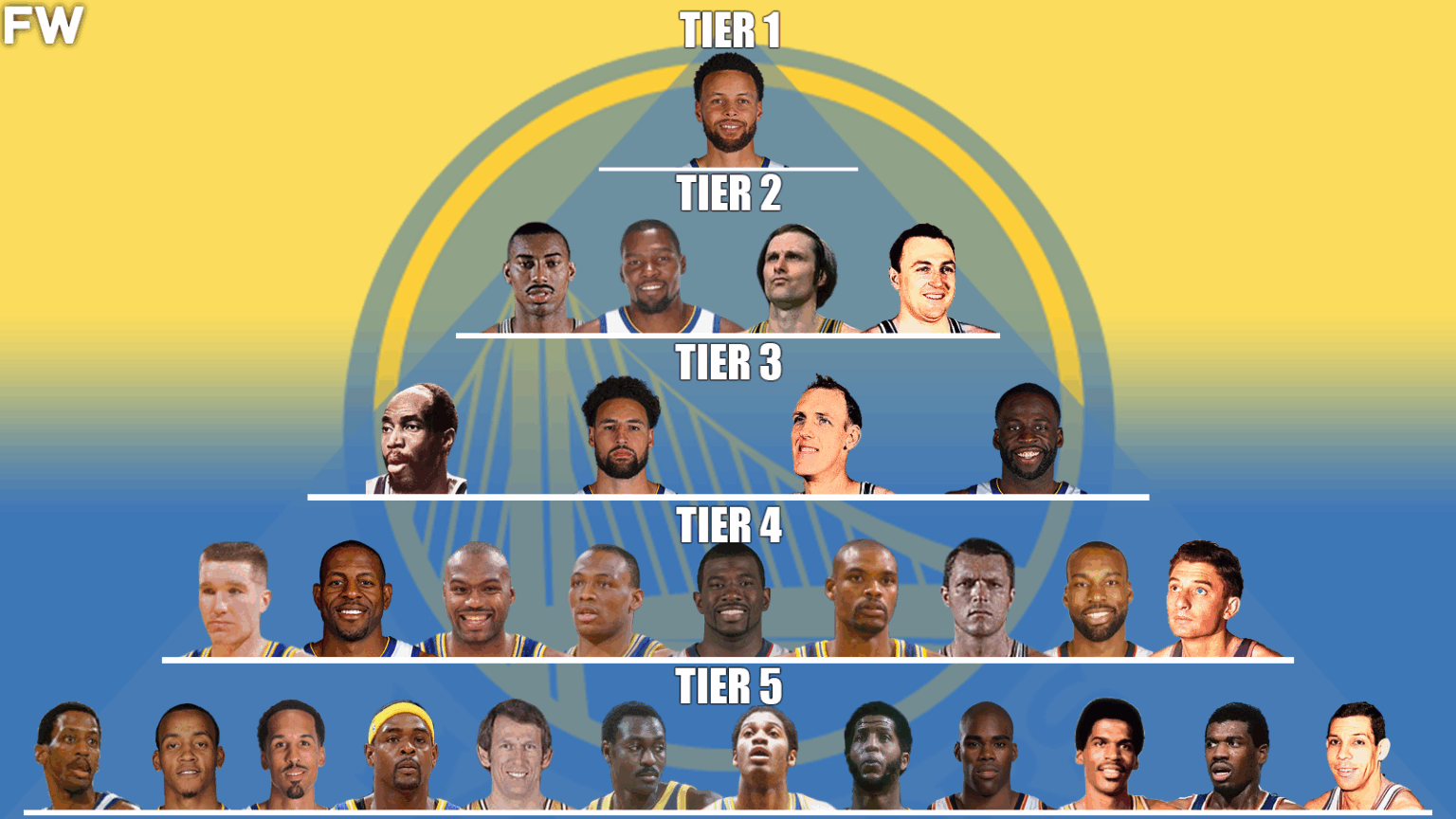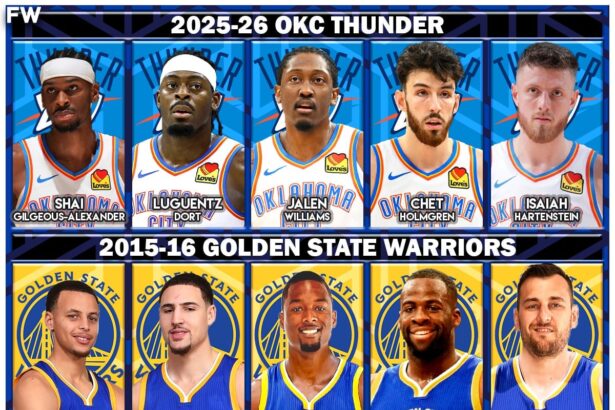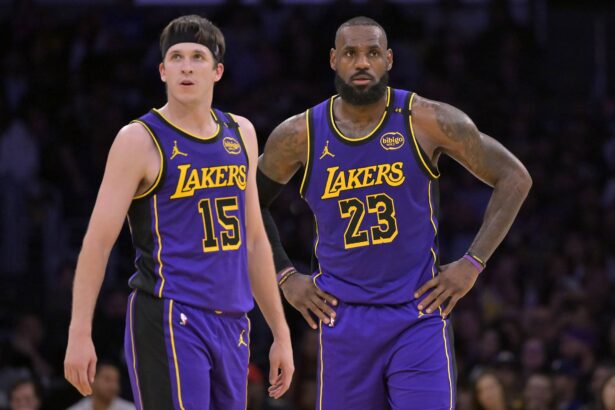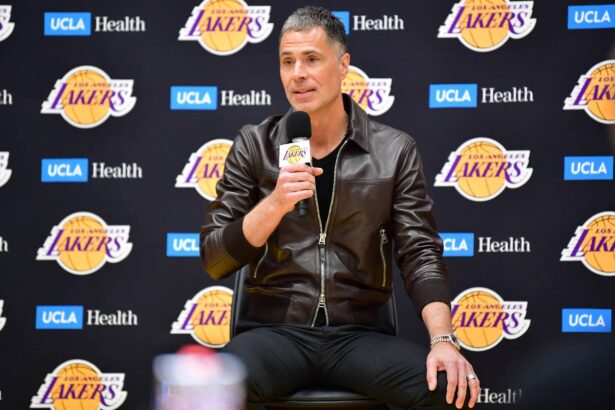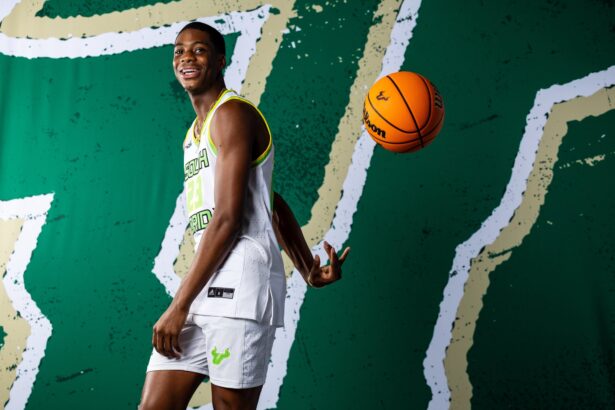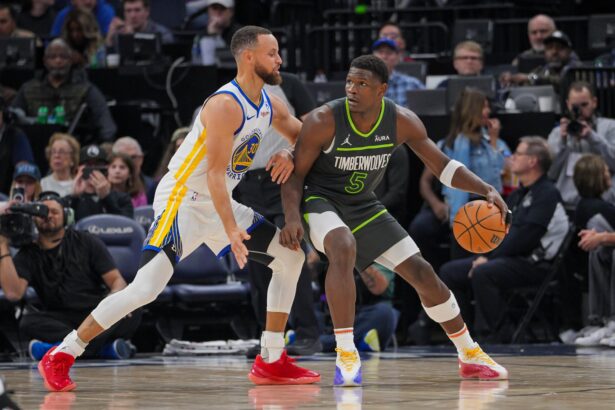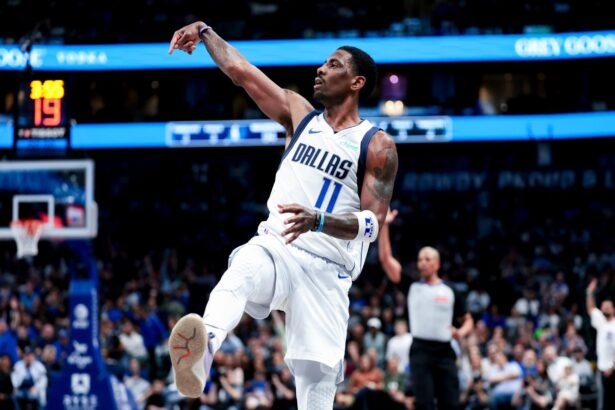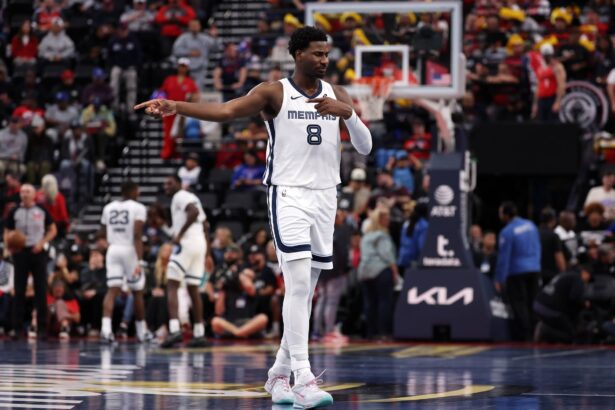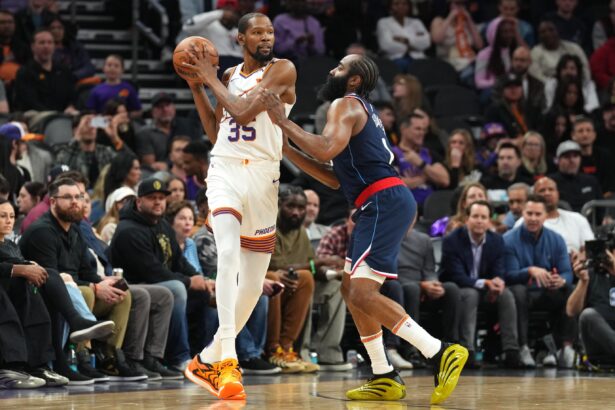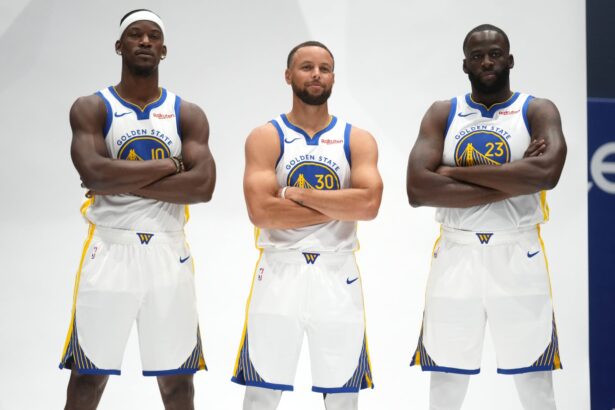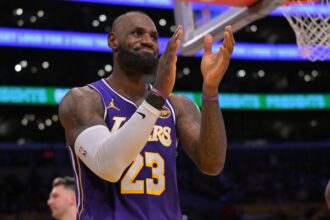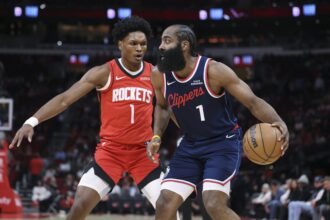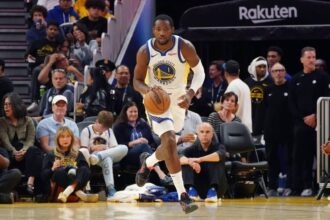The Golden State Warriors are one of the most historic and storied franchises in NBA history. The franchise was founded in 1946 in the City Of Philadelphia, where they remained until 1962, when they moved to the Bay Area. They changed their moniker to Golden State 9 years later after holding the San Francisco name for 9 seasons. They have won 7 NBA championships in their history and have won 7 conference titles as well. Their overall record in the NBA Finals is 7-4, and the team holds the 3rd-most NBA Finals appearances in NBA history with 12.
When a team is around as long and has had as much success as the Warriors, the field of legends that have come through is robust. From Wilt Chamberlain, Rick Barry, and Nate Thurmond to Stephen Curry, Kevin Durant, and Klay Thompson, the Warriors has had some of the greatest players in NBA history wear their jersey. Today, we will rank these Warriors legends by Tiers until we narrow things down to the one and only GOAT of the franchise.
This is the Golden State Warriors all-time GOAT pyramid.
Tier 5
Sleepy Floyd, Monta Ellis, Shaun Livingston, Chris Webber, Jeff Mullins, Purvis Short, Joe Barry Carroll, Jamaal Wilkes, Antawn Jamison, Robert Parish, Bernard King, Guy Rodgers
Tier 5 of the Golden State Warriors GOAT pyramid is filled with lower-level All-Stars and players who made significant impacts in the role they played while with the team. The first of these players is Sleepy Floyd, who played for the Warriors from the last half of 1982-83 thru the first half of 1987-88. Floyd made the only All-Star appearance of his career with the Warriors in 1986-87 when he averaged 18.8 PPG, 10.3 APG, and 1.8 SPG.
The next player up in Tier 5 is the man they called the Mississippi Bullet, Monta Ellis. Monta Ellis was one of the fastest and most exciting players in the 2000s who could light up the scoreboard at the flip of a switch. Ellis never made an All-Star appearance in his career, although he probably should have. From 2006 thru 2012 with the Warriors, Ellis averaged 19.6 PPG, 4.4 APG, and 1.7 SPG on 46.5% shooting. His trade in 2012 made way for Stephen Curry to step into the starting point guard role.
Shaun Livingston’s story is one of heartbreak and triumph. After making his way back from the most horrific on-court injury in NBA history, Livingston bounced around until he landed with Golden State in 2014-15. Livingston became a premier piece for Golden State off the bench during this time and would end up being a part of 3 NBA championship teams. With his pinpoint accuracy from the mid-range and motor that never let up, Livingston became a favorite of the fans in the Bay Area.
Chris Webber’s time with the Warriors was brief but impactful. That’s right, Webber played just his rookie season with the Warriors before irreconcilable differences with Head Coach Don Nelson forced Webber’s way out. In that one season with the team, Webber won Rookie of the Year, playing 76 games in 1993-94. Webber averaged 17.5 PPG, 9.1 RPG, 1.2 SPG, and 2.2 BPG in his only season with Golden State.
Jeff Mullins played for the San Francisco and Golden State Warriors from 1967 thru when he retired in 1976. In his 10 seasons with the Warriors, Mullins went to 3 All-Star Games and was a member of the 1975 NBA championship team. In his All-Star seasons, Mullins averaged 21.9 PPG, 5.2 RPG, and 4.5 APG and shot the ball at 46.6%. In the 1975 championship run, Mullins averaged just 8.1 PPG as it was near the end of his career.
Purvis Short was a talented scorer and pure offensive maestro on the floor, where he spent most of his career with the Golden State Warriors. With the moniker Never Nervous Purvis, short always seemed to step up when it mattered most. He played 9 seasons with Golden State from 1979 thru 1987 but was never named to an All-Star team. He peaked with the Warriors in 1984-85 when he played 78 games and averaged 28.0 PPG, 5.1 RPG, and 1.5 SPG.
In 1980, the Golden State Warriors used their No. 1 overall pick in the NBA Draft on 7’0’’ big man Joe Barry Carroll. He would play with the Warriors from 1981 thru 1984 before heading overseas for one season in China. In those 4 seasons, Joe Barry Carroll became a consistent 20.0 PPG scorer and grabbed at least 8.0 RPG. Upon his return from China, he became an All-Star in 1986-87 with 21.2 PPG and 7.3 RPG, which was his second straight season with similar numbers.
Jamaal Wilkes is more known for his time on the Lakers than the Warriors, but his time with Golden State shouldn’t go unnoticed. After being drafted 11th by the Warriors in 1974, Wilkes went on to win Rookie of the Year honors, with the team averaging 14.2 PPG, 8.2 RPG, and 1.3 SPG. He was named an All-Star for the first time the following year, averaging 17.8 PPG, 8.8 RPG, and 1.2 SPG. He finished his 3rd and final season with the Warriors in 1977 with 17.7 PPG, 7.6 RPG, and 1.7 SPG. He signed with the Lakers as a free agent that offseason while the Warriors received cash and a draft pick as compensation.
Antawn Jamison played with the Golden State Warriors from 1998-99 thru 2002-03. Jamison was the victim of playing some really good basketball with some pretty subpar teams in Golden State and their best season with Jamison came in 2002-03 with 38 wins. Jamison played just 47 and 43 games in his first two years with the team but shined bright in his 3rd year. He played 82 games and averaged 24.9 PPG to go with 8.7 RPG and 1.4 SPG. Jamison’s final year with the Warriors came in 2002-03, when he averaged 22.2 PPG and 7.0 RPG in 82 games played as well.
Robert Parish is another NBA legend who entered the NBA history books with the Boston Celtics during the 1980s. Before he started winning titles in Beantown, Parish played his first 4 seasons with the Golden State Warriors from 1977 thru 1980. After a subtle rookie year, Parish averaged over 17.0 PPG and 10.0 RPG in each of his final 2 seasons with the Warriors. The 1978-79 season was particularly special as Parish broke out playing 76 games and averaging 17.2 PPG, 12.1 RPG, 1.3 SPG, and 2.9 BPG. Parish would go on to win 3 NBA championships with the Celtics during the 80s alongside Larry Bird, Kevin McHale, and a host of other Boston legends.
Bernard King comes off appearances on both the Knicks and Nets GOAT pyramids, appearing for the third time with the Golden State Warriors. King played just 2 years with the Warriors in between his stints with New Jersey and New York. He played 81 games in his first year and was a 20.0 PPG scorer for the team. In 1981-82, King earned the first All-Star selection of his career, with the Warriors averaging 23.2 PPG, 5.9 RPG, and 1.0 SPG. King’s time with the Warriors was short but memorable as just the beginning of a legendary career.
The final member of Tier 5 for Golden State is Hall Of Famer Guy Rodgers. Starting with the Warriors in Philadelphia in 1958-59, Rodgers was a gifted passer for his time. After 4 seasons in Philly, Rodgers took off when the team relocated to San Francisco. He earned 2 All-Star selections in the team’s first 2 seasons in the Bay Area, leading the NBA with 10.4 APG in 1963 and averaging 11.0 PPG and 7.0 APG in 19664. He earned his 3rd All-Star selection in his final year with the team in 1966. He averaged 18.6 PPG and 10.7 APG that season but the Warriors won just 35 games.
Tier 4
Chris Mullin, Andre Iguodala, Tim Hardaway, Mitch Richmond, Jason Richardson, Latrell Sprewell, Tom Gola, Baron Davis, Joe Fulks
Only 6 players in Warriors history have had their jerseys retired by the Golden State Warriors in their team’s history. Tier 4 kicks off with one of those players with a case for Tier 3, Chris Mullin. He played 13 seasons with the Warriors from 1986 thru 1997 and his final season in 2001. Mullin led the NBA in games played 3 different times and minutes played twice. He made 5 straight All-Star games from 1989 thru 1993 and averaged 25.8 PPG on 52.3% shooting over that span. Mullin embodied what it meant to be a Warrior and the only thing holding him back from Tier 3 is a championship.
Andre Iguodala has not only been a staple in Golden State as a veteran presence but perhaps one of the more impactful as well. Iguodala joined the Warriors in 2014 as one of their key rotational players off the bench. In the 2015 NBA Finals, Iguodala was rewarded for his defensive efforts on LeBron James with a Finals MVP award. He would win 2 more titles with the Warriors in 2017 and 2018 as a role player off the bench, but his defensive impact still stood true.
Tim Hardaway is the second member of Run TMC to crack into Tier 4 as a member of the Warriors from 1990 thru the first half of 1996. Hardaway was selected 14th overall in the 1989 NBA Draft and made a significant impact on the team upon arrival. He would make 3 straight All-Star teams from 1991 thru 1993 and 2 All-NBA Teams as well before injuring his knee severely. In each of the 1992 and 1993 seasons, Hardaway averaged at least 20.0 PPG and 10.0 APG for the year and was considered to be among the best point guards in basketball.
The 3rd and final member of Run TMC, Mitch Richmond, joins his running mates in Tier 4 as well. Richmond is considered to be one of the best scorers in the 90s with the Kings, but it all started in Golden State. Richmond was selected 5th overall in 1988 by the Warriors and immediately confirmed their selection. He was Rookie of the Year for 1989 with 22.0 PPG, 5.9 RPG, 4.2 APG, and 1.0 SPG. He played just 3 years with the Warriors before being dealt to Sacramento but averaged 22.7 PPG in those 3 years.
Jason Richardson is another drafted Warrior on Tier 4 as their 5th pick in the 2001 NBA Draft. Richardson was a Warrior for 6 seasons and had some of the best seasons of his career with the team. He was a leader of the 2007 We Believe team that stunned the Mavericks in the playoffs that year and his athleticism took center stage. As a high-flyer and powerful dunker, Richardson was also a talented scorer who averaged 23.2 PPG and 5.8 RPG with Golden State at his peak.
Aside from an infamous choking incident, Latrell Sprewell enjoyed great years with Golden State too. His second season as a pro turned out to be his most impressive with the Warriors, as he averaged 21.0 PPG, 4.9 RPG, 4.7 APG, and 2.2 SPG. He made the All-Star, All-NBA, and All-Defensive Teams that season, never doing so again in his career. He would earn 2 more All-Star selections as a Warrior, but never the latter 2. In 6 seasons with the Warriors, Sprewell averaged 20.1 PPG, 4.3 RPG, 4.7 APG, and 1.7 SPG.
Tom Gola was drafted by the Warriors in 1995, won a championship in 1956, served in the Army in 1957, and was an All-Star by 1960 in the early days of the Warriors in Philadelphia. Golden State’s most interesting man played seven total seasons with the team during the 50s and 60s and was a great guard/forward over that time. In his 4 All-Star seasons with the Warriors, Gola averaged 13.8 PPG, 9.1 RPG, and 4.6 APG. Gola would earn more honors with the Knicks until he retired in 1966.
Who can ever forget Baron Davis’ sensational performance for the Warriors in 2007? As a Mavericks fan, I could never forget the way Davis completely demoralized Dallas in the first round of the playoffs breathing life into a fanbase that had little to cheer for quite some time. Davis spent 3 and a half years with the Warriors during the mid-2000s, the lifeblood behind the Warriors’ resurgence around that time. Davis would win a steals title in 2007 with the Warriors on top of his incredible playoff success that year. Davis is a Golden State legend with or without the title and sits right next to other Warriors greats in the same boat as he.
The final member of Tier 4 or Golden State is Warriors lifer Joe Fulks. Fulks played his entire career with the Philadelphia Warriors from 1947 through 1954; along the way, he became a BAA champion as a rookie who led the league in scoring with 23.2 PPG. He led the league the next year in scoring as well, with 22.1 PPG. He earned 2 All-Star appearances in 1951 and 1952 as well, leading the NBA in free throw percentage at 85.5% in 1951. Fulks helped deliver the 1st title in franchise history which gets him a spot on Tier 4.
Tier 3
Nate Thurmond, Klay Thompson, Neil Johnston, Draymond Green
Tier 3 is when we begin to enter the superstar portion of Golden State’s long and storied history. The first of these Tier 3 players is Nate Thurmond, who helped ease things along when Wilt Chamberlain left to join the 76ers. Thurmond played the first 11 seasons of his career with the Warriors and earned 7 All-Star appearances along the way. He helped the team make 6 playoff appearances during his time with them. Thurmond was a scoring and rebounding machine with a 17.4 PPG and 16.9 RPG average for his career there. He peaked in 1968 when he averaged 20.5 PPG and 22.0 RPG in 51 games.
The next member of Tier 3 is one of the greatest shooters in NBA history, Klay Thompson. He has been a pivotal member of 4 NBA championship teams with Golden State and one-half of the greatest shooting backcourt in NBA history. In his career so far, he has earned 5 All-Star selections, 2 All-NBA Team selections, and 1 All-Defensive team selection. Since 2015, Thompson has averaged 20.0 PPG in every season he has played, even after returning from 2 severe lower leg injuries.
Neil Johnston is another Warriors great for the older days of the franchise who makes his way onto Tier 3. Johnston played all 8 years of his career with the Warriors from 1952 thru 1959. Johnston won 3 straight scoring titles from 1953 thru 1955, as well as led the NBA in field goal percentage 3 times. He helped the Warriors win the 1956 NBA championship with 20.3 PPG and 14.3 RPG during the playoffs.
The final member of Tier 3 is one of the most impactful players with some of the most average stats in NBA history. Draymond Green isn’t going to blow the average fan away with high-scoring performances, but he will play a huge part in a successful franchise. He is the ultimate defender and playmaker as someone who directs the defense and makes the offense click on all the right cylinders. Green has helped the Warriors win 4 NBA titles as well as winning a Defensive Player of the Year award, and has been selected to 7 All-Defensive Teams, 4 All-Star Teams, and 2 All-NBA Teams.
Tier 2
Wilt Chamberlain, Kevin Durant, Rick Barry, Paul Arizin
Tier 2 is where we enter the icon phase of our Warriors GOAT pyramid. The Tier kicks off with the Warriors’ GOAT for most of their existence and Wilt Chamberlain’s dominance over the NBA. Wilt began his career with the Warriors in 1960 and would go on a tear that we may never see again. He won the first 4 scoring titles and 4 rebounding titles in the first 4 years of his career and averaged 50.4 RPG and 25.7 RPG in 1962. He won the 1960 MVP award as a rookie, along with the obvious Rookie of the Year. In his 6 seasons with the Warriors, Wilt averaged an incredible 41.5 PPG, 25.1 RPG, and 3.0 APG. Before our selection for Tier 1 came along, he was the undisputed GOAT of the franchise.
The next selection for Kevin Durant is sure to draw some controversy. After challenging the Warriors in the 2016 Western Conference Finals and falling short, Durant opted to join the Warriors following the season via free agency. Durant would go on to form one of the greatest teams ever assembled as they appeared in 3 straight NBA Finals, going back-to-back as champions in 2017 and 2018. Durant was named the Finals MVP of both Finals victories, etching his name into Warriors history forever. You may hate the move or even the man behind it, but what was accomplished on the court cannot be denied.
Aside from the 4 seasons he played in the ABA, Rick Barry played most of his professional seasons as a member of the Warriors. He made his debut for the Warriors in 1966 and, in 1967, took home the scoring title with an average of 35.6 PPG. Barry returned in 1973 and picked up right where he left off as a tremendous scorer and elite defender. Barry led the Warriors to the NBA championship in 1975 and took home the Finals MVP award when he averaged 29.5 PPG, 4.0 RPG, 5.0 APG, and 3.5 SPG. Barry is 3rd in franchise history in points, 5th in assists, and 4th in steals.
The final member of Tier 2 was a lifetime member of the Warriors franchise from 1951 thru 1962. Paul Arizin made his debut for the Philadelphia Warriors in 1950-51. In his 2nd season, he would win his first scoring title with 25.4 PPG on a league-leading 44.8% shooting. Arizin then spent 2 seasons in the Marine Corps before returning to play for the Warriors in 1954-55. Arizin would be an All-Star every season of his career, averaging at least 20.0 PPG every season aside from his first. Over 10 seasons, Arizin averaged 22.8 PPG and 8.6 RPG for the Warriors and earned 4 All-NBA Team selections along with credit for leading them to the 1956 NBA championship.
Tier 1
Stephen Curry
For the Warriors’ GOAT, we have decided on the player who single-handedly changed the way basketball is played over the last decade, Stephen Curry. In the last 8 seasons specifically, we have seen Stephen Curry evolve into the greatest shooter the game has ever seen, a winner, and one of the most valuable and impactful players of all time. Curry is the only unanimous MVP in NBA history, one of his 2 MVP awards, and is the all-time record-holder for 3-pointers made as well as the Warriors’ all-time leading scorer. He has led and been an immensely important piece of 4 NBA championships as well as a Finals MVP award in 2022.
Curry has turned the Warriors into a dynasty with the 3rd-most NBA championships in NBA history, including 4 in 8 seasons. Curry’s ability to score and create shots from a ridiculous range has everyone and their brother thinking that they can shoot at a high volume and high efficiency from beyond the three-point line. However, there is only one 3-point king who stands alone atop the Warriors hierarchy, and there is only 1 Stephen Curry.
We sincerely appreciate and respect you as a reader of our site. It would help us a lot if you follow us on Google News because of the latest update.
Thanks for following us. We really appreciate your support.

